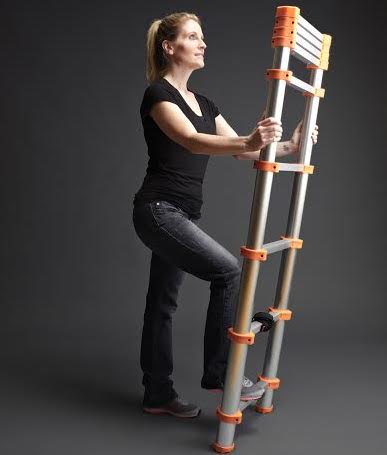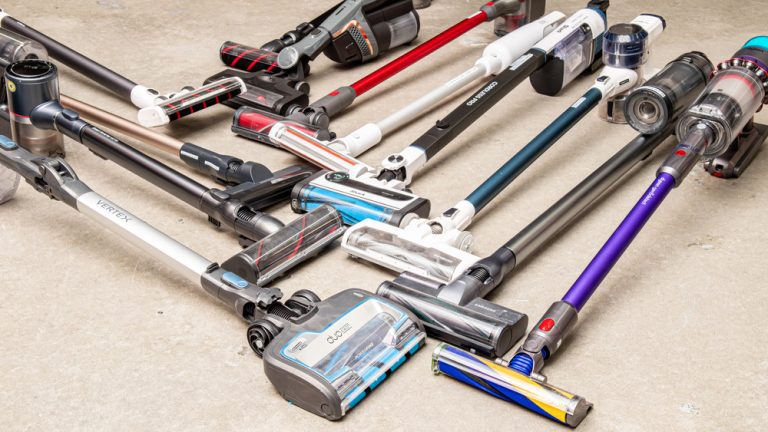How to Use Telescoping Ladder?

To use a telescoping ladder, ensure it’s fully extended and locked in place before climbing. Place it on stable, level ground to prevent slipping or tipping.
Telescoping ladders offer a blend of convenience and functionality, providing an extendable design that’s perfect for tasks requiring varying heights. These ladders are an excellent choice for professionals and DIY enthusiasts alike, due to their compact storage capabilities and adjustable nature.
Easily portable and versatile, telescoping ladders require proper handling to ensure safety. With multiple height options and straightforward operation, they are ideal for both indoor and outdoor projects. Always prioritize safety by following the manufacturer’s instructions and checking for secure locking before use. Your tasks will be within reach with this smart and flexible climbing tool that’s easy to maneuver and set up.

Credit: xtendandclimb.com
Introduction To Telescoping Ladders
Telescoping ladders have redefined the convenience of height access. Unlike traditional ladders, these marvels collapse to a portable size. They slide and lock into place, offering a full-sized ladder when extended. This design caters to a range of tasks, from changing lightbulbs indoors to gutter maintenance outdoors.
The Rise Of Compact Ladders
Compact ladders are gaining popularity. Their rise reflects a trend towards space-saving and multi-functional tools. These ladders fit into small storage areas, ideal for modern homes with limited space.
Advantages Of Telescoping Designs
Telescoping ladders boast several advantages. Here’s a glimpse:
- Ease of Storage: Collapses to compact sizes.
- Portability: Lightweight with carry handles.
- Adjustable Height: Extends to specific needs.
- Durability: Built with robust materials.
- Stability: Features safety locks for secure use.

Credit: m.youtube.com
Safety First
Using a telescoping ladder can make tasks higher up much easier, but safety always comes first.
Before climbing, knowing the correct procedures can help prevent accidents. Let’s focus on how to check, place, and lock your telescoping ladder securely.
Pre-use Checks
Always inspect your ladder before using it. Look for any visible damage like bends, cracks, or corrosion. Ensure each section is free from dirt or debris, as this can affect the ladder’s stability. Check for loose components that could compromise safety.
- Inspect for damage
- Clean dirt or debris
- Check for loose parts
Safe Placement And Angle
Find level ground to set up your telescoping ladder. Avoid slippery or uneven surfaces to minimize risks. The correct angle is essential for stability. Use the 1-to-4 rule: for every four feet of ladder height, move the base one foot away from the wall.
| Ladder Height | Base Distance from Wall |
|---|---|
| 4 feet | 1 foot |
| 8 feet | 2 feet |
| 12 feet | 3 feet |
Locking Mechanisms 101
Locks are vital for your safety when using a telescoping ladder. Prior to ascending, ensure all locking mechanisms are fully engaged. This keeps the ladder extended and prevents it from collapsing. Listen for the click of locks and verify visually.
- Extend the ladder fully
- Ensure locks click into place
- Double-check visually and audibly
Setting Up Your Telescoping Ladder
Setting Up Your Telescoping Ladder is a critical step to ensure its safe and effective use. Whether you’re a pro handling tasks on various job sites or a DIY enthusiast reaching for that high shelf, proper ladder setup is key. The right setup prevents accidents and makes your work easier. This guide walks through essential steps and tips to deploy your ladder correctly.
Step-by-step Deployment
Unfolding a telescoping ladder is straightforward. Follow these steps:
- Place the ladder on a firm, flat surface.
- Unlock the side latches at the bottom rung.
- Lift the ladder from the bottom, allowing each section to click into place securely.
- Ensure all rungs are locked before climbing.
Stabilizing On Different Terrains
Telescoping ladders require a stable base to operate safely. Consider terrain type during setup:
- Soft Ground: Use wide-base stabilizers for soft or uneven ground.
- Slippery Surfaces: Make sure ladder feet have anti-slip padding.
- Leveling: Adjust the ladder’s length or feet on slopes to maintain balance.
Proper Extension And Retraction Techniques
Extending and retracting your ladder correctly prevents damage and extends its lifespan:
- Extend the ladder from the bottom, securing each rung.
- Do not over-extend beyond the maximum indicated height.
- To retract, release the rungs from the top down, pausing to let the air clear between sections.
- Always keep fingers clear to avoid pinching.
Bold the lock indicators once you have fully extended each section. Treat your telescoping ladder with care for long-lasting utility and safety in all your projects.
Using Your Ladder Effectively
Telescoping ladders offer flexibility and convenience for a variety of tasks. Whether painting a room, cleaning gutters, or changing light fixtures, using your ladder effectively is crucial. This section guides you through setting up and using your telescoping ladder safely and efficiently.
Optimizing Height And Position
Choose the perfect height for your task to prevent overreaching. Position the ladder on solid, level ground to maintain stability. Keep in mind that the ladder should extend at least three feet above the surface you intend to reach for maximum safety and ease of use.
Handling Tools And Equipment At Height
- Always climb with care, keeping three points of contact.
- Use tool belts or attachable tool caddies to keep hands free.
- For heavier equipment, use a hoist or have a partner hand items to you.
Transitioning To And From The Ladder
- Before ascending, ensure all locks are fully engaged.
- Move slowly and deliberately to maintain balance.
- Never jump off the last rung; always climb down carefully.
Maintenance And Care
Keeping your telescoping ladder in top shape enhances safety and extends its lifespan. Regular maintenance and proper care are the keys to the ladder’s smooth operation. Dive into routine cleaning, savvy storage, and when to consult a professional for servicing or upgrading your ladder.
Routine Cleaning Procedures
Cleanliness ensures your telescoping ladder functions properly. Dust, dirt, and grime can hamper its mechanisms. Here’s how to keep it pristine:
- Wipe down each rung with a damp cloth.
- Use a mild soap solution for greasy spots.
- Ensure no water remains inside the ladder.
- Dry thoroughly before closing the ladder.
Storage Solutions For Longevity
Proper storage preserves your ladder’s integrity. Follow these tips for optimal storage solutions:
- Store in a clean, dry area to avoid rust.
- Keep it away from harsh chemicals and direct sunlight.
- Store horizontally on supports to prevent bending.
When To Service Or Replace
Telescoping ladders are robust, but not indestructible. Recognize the signs for when to service or replace:
- Inspect regularly for loose parts or damage.
- Service if mechanisms stick or fail.
- Replace when wear and tear is evident.
- Consult a professional for any doubts.
Common Mistakes To Avoid
Working with a telescoping ladder seems straightforward. Yet, simple errors can lead to mishaps or damage. Awareness is key to using telescoping ladders efficiently and safely. Let’s review common mistakes users should always avoid.
Neglecting Safety Protocols
Safety must be your top priority. Not following the essentials may cause accidents. Here are steps you should take:
- Inspect the ladder before use. Check for any damages or defects.
- Ensure it is fully extended. Lock each rung in place before climbing.
- Position the ladder properly. Place on a flat, stable surface at the right angle.
- Wear appropriate footwear. Non-slip shoes are a must.
- Never exceed the weight limit. Check the ladder’s maximum capacity.
Forcing Mechanisms
Telescoping ladders have delicate mechanisms. Forcing them can break the system. Follow these guidelines:
- Extend and retract smoothly. Avoid quick, forceful actions.
- Use the locking mechanisms correctly. Ensure they are engaged fully.
- Do not pull or jerk on rungs. This could misalign the ladder.
Ignoring Manufacturer’s Guidelines
Each ladder model comes with its own set of instructions. Ignoring these details is risky. Always:
- Read the manual first. Understand your ladder’s features and limitations.
- Follow the recommended usage. Use as directed by the manufacturer.
- Be aware of maintenance advice. Proper care extends the ladder’s lifespan.

Credit: www.amazon.com
Frequently Asked Questions On How To Use Telescoping Ladder?
What Is A Telescoping Ladder?
A telescoping ladder is a versatile and space-saving climbing tool. It features sections that collapse into each other, allowing for adjustable height and compact storage. Ideal for both professional and home use due to its portability and variable length.
How Do You Safely Use A Telescoping Ladder?
To use a telescoping ladder safely, ensure it’s fully extended and locked into place. Position it on stable, level ground at the correct angle, typically 75 degrees. Always face the ladder and maintain three points of contact when climbing or descending.
What Are The Benefits Of Using Telescoping Ladders?
Telescoping ladders offer numerous benefits, including ease of storage, transportability, and flexible height adjustment. They’re perfect for those needing a reliable ladder that can be easily moved and adjusted to suit various tasks in different environments.
Can Telescoping Ladders Be Used On Uneven Surfaces?
Using telescoping ladders on uneven surfaces requires a stabilizing accessory, such as a leveler or base stabilizer. These accessories help ensure the ladder remains secure and safe. Never use a telescoping ladder on an uneven surface without proper stabilization.
Conclusion
Mastering the art of telescoping ladders ensures your safety and efficiency in various tasks. Remember to always prioritize secure positioning and routine maintenance checks. With these tips, your telescoping ladder can be a reliable tool for home or professional use.





